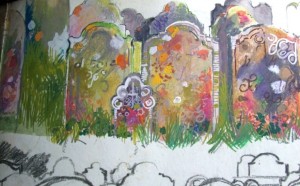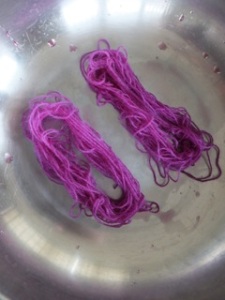In my last post I started to write about orchil, and how I became fascinated by its story through my researches on an eighteenth / nineteenth century Wood & Bedford / Yorkshire Chemicals archive.
To start at the beginning, orchil (pronounced or-kil) comes from lichens. It has been used for millennia to dye wool and silk a purple colour. There is some confusion over ancient recipes for purple. It isn’t always possible to decipher which recipes refer to lichen and which to shellfish dyes. Both dyestuffs produce a remarkably similar colour, were to be found in the same areas (e.g. the Mediterranean coast) and descriptions of lichen are often a little vague. For instance, dyestuff might be referred to as a plant, or a moss, or a seaweed.
There is evidence (Pliny, Theophrastus, Dioscorides) that orchil was used in conjunction with shellfish purple and it’s a ready assumption that this was done to defraud – which of course it may have been. The processing of orchil would have been significantly cheaper than for shellfish dye. But the combination was also undertaken to produce a legitimately cheaper alternative to pure shellfish-dyed cloth. Nevertheless, orchil and shellfish-dyed cloth seems regarded with disdain because of the great and unique reputation of shellfish purple, and orchil’s tendency to fade.
Orchil dye is extremely beautiful in its first, fresh bloom of colour but it normally proceeds to fade fast. It is therefore interesting to read a 2012 paper (link below) in which Casselman and Terada demonstrated that a combination of orchil and shellfish dye may in certain circumstances, stabilise the orchil. They also reported that the use of orchil as a base dye would to some extent neutralise the intensely unpleasant odour of shellfish-dyed cloth. Those facts cast an entirely different light on the historic combination of orchil and shellfish dye.
It occurs to me that in more recent days, far from being ‘poor man’s purple’, orchil could have been considered a great luxury. If you could afford the rich glories of orchil-dyed silk, and these would be obvious to all by the colour, it might indicate one’s financial indifference to fading and the realities of a soon-spoiled garment.
Dye lichens
Not all lichens will dye, not all dye lichens will make orchil. Orchil-producing lichens (and there are innumerable species) contain precursors of the dye and to make this available the dyestuff must be crushed in ammonia or stale urine and water and then kept well-oxygenated. It undergoes a type of fermentation, and the purple colour develops over several weeks.
Orchil is very sensitive to changes in pH and by adjusting vat strength and acidity, a wide variety of colours can be achieved, ranging from browny reds to reds, pinks and purples.
Crotal / crottles
There are lichens that will dye rusty reds, browns and golds. They are often referred to as ‘crotal’, (a Gaelic word) or crottle, lichen. These require no fermentation and are normally boiled up together with fibre, yarn or cloth. They have been in traditional use in Scotland for centuries and the warm, earthy smell of crotal-dyed yarn is also a moth deterrent. But crotals are not orchils!
Mordants
Neither orchil nor crotal requires a mordant although some historical recipes recommend an alum mordant for orchil.
The Wood & Bedford Orchil Story
I found a vast number of items in the archive which related to the nineteenth and twentieth century trade in orchil. A couple of them can be seen in the previous post. The records defined several sources of orchil lichen. Around 1830 these included Scandinavia, Sardinia, the Azores, Madeira, the Canary Islands and Cape Verde. Political changes and colonial interests affected trading in the later 1800s, as did the slave trade and, eventually, its abolition. A picture emerged of a voracious trade that reached an industrial and even global scale by the mid nineteenth century. There is a certain irony in the fact that stocks of what, in effect, is a non-renewable product were saved by the synthesis of mauveine by Perkin in 1856. The demand for lichen then dropped. Nevertheless, Wood & Bedford, later the Yorkshire Dyeware and Chemical Company, continued to buy and process orchil lichen well into the twentieth century. I understand that the last unused lichen stocks went to Johnsons of Hendon who presumably used lichen to make their indicator papers.
Lichen ethics
You will see that I have learned to make orchil and to dye samples for research purposes but I don’t use it in my studio work. You can read some of my thoughts on lichen use here. I am extremely grateful to all those who taught me about making orchil and how to dye with it.
Pronunciation
How do you pronounce lichens? I say it to rhyme with kitchens. Most people and academics (ok, sorry, academics are also people) say ‘likens’. The OED pronunciation makes it official: you can say it either way:
/ˈlʌɪk(ə)n, ˈlɪtʃ(ə)n/
References:
The Politics of Purple: Dyes from Shellfish and Lichens Karen Diadick Casselman and Takako Terada
Natural Dyes: Sources, Tradition, Technology and Science; Dominique Cardon, Archetype Publications
The Colourful Past: Origins, Chemistry and Identification of Natural Dyestuffs; Judith H. Hofenk de Graaff, Archetype Publications
Lichen Dyes: The New Sourcebook and Craft of the Dyer by Karen Diadick / Leigh Casselman








